Microsoft pulled the plug on Windows XP support last year in April, but around 18 percent of the world's computers are still running it despite the obvious security risks caused by a platform which no longer receives updates and patches.
Many companies, however, decided to purchase custom support for Windows XP in order to get more time before upgrading, but those who haven't yet completed the transition will have to pay much more starting April 2015.
After 12 months of custom support, Microsoft is doubling prices for new updates and security patches, not necessarily in a move to make more money out of this, but in order to encourage more companies to upgrade to a newer OS version.
What's more, the number of computers still running a specific OS build 2 years after its launch is clearly very low, so keeping a team just for patching these computers would be costly.
So starting April this year, those who are still on Windows XP and want updates from Microsoft will have to pay $400 (€350) per PC, up from the current price of $200 (€150) per PC, according to information obtained by CW.
The world not yet ready to jump ship
Statistics show that Windows XP is still powering some 18 percent of the world's computers, which is living proof that not all users can be convinced to upgrade for various reasons.
First of all, a Windows XP machine needs to be upgraded before running newer operating systems, such as Windows 8.1, so the whole process could become really expensive. For companies with hundreds or thousands of PCs, this is clearly a very costly transition, so pushing it back for as long as possible is a priority.
The launch of Windows 10, due in the fall of 2015, is likely to boost the migration off Windows XP, especially because it would retain the familiarity of the traditional Windows operating system, while also adding new modern features.
Windows 10 will be offered free of charge for Windows 7 and Windows 8.1 users within the first year after launch, but enterprises will still have to pay for it.

 14 DAY TRIAL //
14 DAY TRIAL //